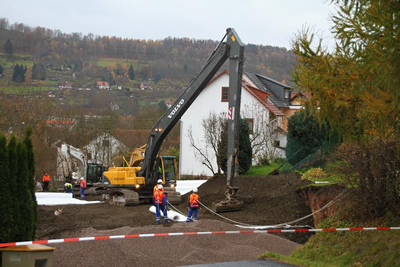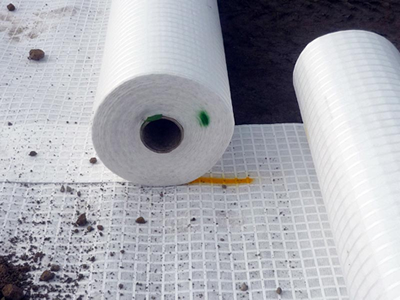
An extraordinary crater in Schmalkalden, Thuringen became Germany’s most prominent sinkhole after its sudden development on an early November day. What made this sinkhole particularly alarming was its development within the middle of a residential area. Geologists suspected that natural cavities were the cause and established test wells to monitor the situation. For three days the earth shifted until finally it settled, leaving behind a 20 m (65 ft.) deep crater.
For days, gravel trucks rolled in, delivering approximately 30,000 tons of 8/16 gravel which was poured into the crater’s mouth. Securing the edge, however, was more critical to provide greater protection against immediate and future shifts.
Right next to the massive hole was a partially slipped embankment, the remains of which were extremely unstable. This threatened a nearby apartment building.
Geosynthetic reinforcement was requested.
A Composite Solution for Sinkholes

Only one week later, rolls of NAUE Combigrid® 30/30 Q1 151/3 were delivered to stabilize the slope.
This particular product is a unique geogrid/geotextile composite material that delivers reinforcement, filtration and separation in a single layer material. (The geotextile component is bonded between the flat geogrid bars during the manufacturing process.)These geogrid/geotextile composites are used in conjunction with soft and low CBR soils for applications such as base reinforcement, embankment reinforcement and pile cap platforms.
From the former garage forecourt (now the area of the sinkhole) to the adjacent residential buildings, a wrapped-face reinforced wall was constructed. Five tiers of the composite geogrid were installed using an envelope method along the front of the embankment to provide permanent stability.
Roughly 6,500 m² (69,965 ft. ²) of geosynthetic reinforcement were installed.
The site remains stable today.
Geosynthetica’s Chris Kelsey published a longer version of this article previously in Land and Water magazine. For more information about sinkhole mitigation or composite reinforcement materials, visit www.naue.com.











